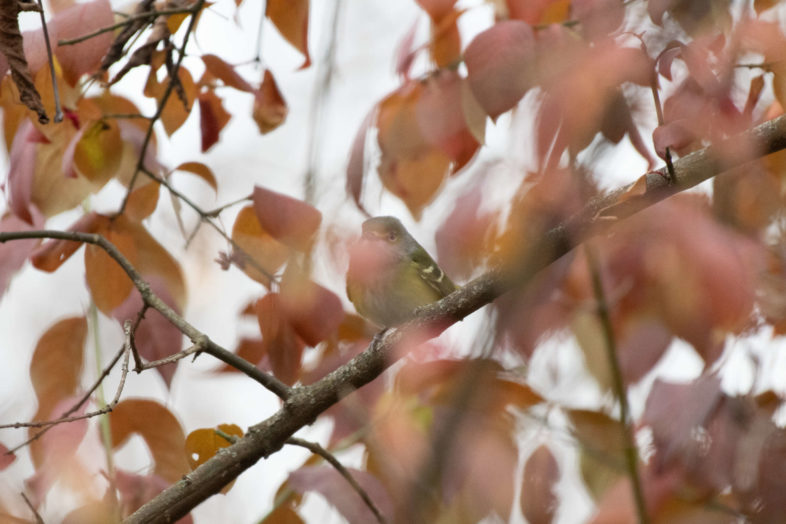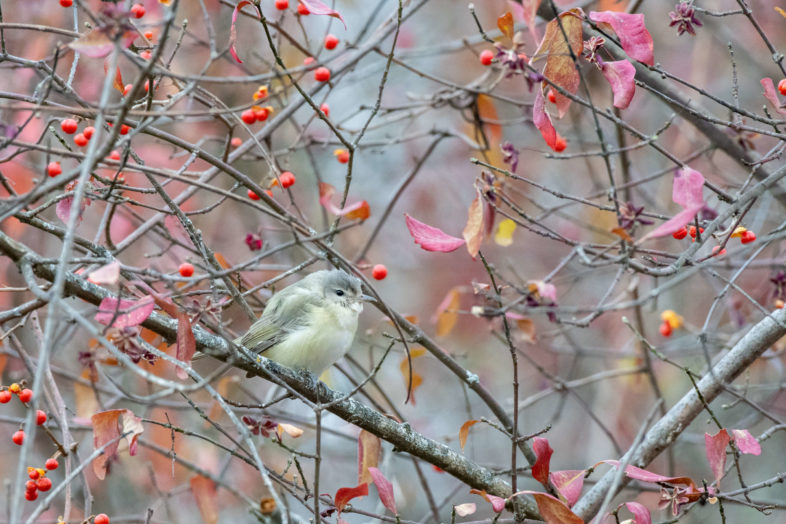
The best photo that anyone was able to capture of a White-eyed Vireo present at Ratcliffe Park in downtown White River Junction over 3 days in late November 2021. The bird chose not to cooperate freely with birders, as it moved constantly through dense thickets and afforded fleeting glimpses at best. 25 November 2021. © Ben Wardrop
It’s not often that vireos steal the birding spotlight, but Windsor County birders have been kept on their toes in recent weeks, with three unexpected occurrences by members of this family. First, Vermont’s first-ever Bell’s Vireo made its debut over 9 days in Woodstock. That in itself was exceptional, and thrilling for the 30 of us who were lucky enough to see the bird. Then, a month later, on two consecutive late November days, eyebrows were further raised by the near-simultaneous—and literally side-by-side—appearance of two equally unanticipated vireos in a small White River Junction park.
On 23 November, a cold and blustery day that felt every bit a harbinger of winter, Kyle Jones was birding behind the Amtrak station in downtown WRJ (waiting for his car to be serviced) when a band of 3 chickadees, with an unfamiliar bird in tow, caught his attention. Binoculars quickly revealed a… White-eyed Vireo, a species that breeds no closer to the Upper Valley than southern New England and should by all rights have been in the southeastern U.S. or Mexico by that date! Kyle—now minted the Windsor Co. Vireo Whisperer—texted yours truly, and I arrived as quickly as I could, proceeding to spend a very chilly hour searching in vain. As I was leaving, Wayne Scott showed up. I wished him luck, and was hardly surprised to learn that he found the bird 45 minutes later in nearby Ratcliffe Park, ∼250 meters south. I had to smile, if a bit ruefully.
The following morning found me and several other birders back at Ratcliffe Park, in sunnier, calmer and decidedly warmer conditions. The White-eyed Vireo was either absent or unwilling to cooperate, but 3 of us had an intriguing and fleeting glimpse of a different bird that looked to be another vireo! This one had no wingbars, eye ring or other prominent markings. We were stymied, and my two fellow birders departed. Sticking it out just a bit longer, I was soon rewarded by a close-up view of the White-eyed—phew, shutout avoided. And, I had yet another tantalizing glimpse of the mystery bird, reinforcing my thought that it was an entirely different species of vireo. Unable to relocate it, I left, thoroughly puzzled.
Day 3 of vireo mania may have been a national holiday, but several birders with questionable priorities (at least in their families’ eyes) again converged on Ratcliffe Park. The White-eyed obliged most, but not all, of us by providing a few momentary glimpses, continuing its habit of near-constant movement through the dense thickets. Thinking that I had the bird in my sights as it roosted with head tucked into back feathers in a shrubby dogwood—looking decidedly cold-stressed—I quickly realized that it lacked wing bars, had a plain gray face, and was a much more drab gray above than the more greenish-gray WEVI. When Cedar Stanistreet and Jim Mead got their eyes on it moments later, and it then flew into very close range while foraging (within a meter at one point), there was no question that we were watching an exceptionally late Warbling Vireo! We were stunned, as the species normally departs Vermont in September, and should have been well >1,000 miles to our south on its Central American wintering grounds. Thankfully, Ben Wardrop captured some excellent photos for confirmation.

A cold-stressed and exceptionally tardy Warbling Vireo at Ratcliffe Park in downtown White River Junction was the latest individual of this species on record for Vermont, and the only individual of its species ever documented during November in northern New England. 25 November 2021.© Ben Wardrop
This bird—arguably more of a surprise on this date than the White-eyed Vireo—turns out to be the latest member of its species ever recorded in Vermont. In fact, it is the ONLY Warbling Vireo ever documented in November for the state, or for all of northern New England. For perspective on just how unusual a late November Warbling Vireo is, I checked eBird records for the month. Here are the few that stood out, from (roughly) north to south:
— 8 November 2021; Tadoussac, Quebec
— 2-20 November 2016; New Glasgow, Nova Scotia
— 5 November 2021; Lunenberg, Nova Scotia
— 16 November 2014; Wolfville, Nova Scotia
— 24 November 2015; Halifax, Nova Scotia
— 7 November 2021; Seneca Falls, NY
— 26 November 2016; Ithaca, NY
There are 4 November records of Warbling Vireo from Massachusetts, three of them coastal, and the latest a Cape Cod bird on 17 November 2018. eBird shows only two December records from eastern North America, one from Cleveland on 12/1/09, another from Baltimore on 12/15/09. Note that fully half of the 8 tardy records above, including the WRJ individual, were documented in 2021! This is far too small a sample to warrant any inferences, but it’s intriguing. We certainly had plenty of warm weather this autumn, but I’m far from convinced that it was exceptionally balmy.
Not to minimize the White-eyed Vireo’s significance as an unusually tardy fall record, but this species does exhibit a track record of showing up well north of its breeding range on some very late dates. In northern New England and Quebec, those include:
— 23-29 November 2014; Burlington, VT
— 12 December 2015 and 2 January 2016 (same bird?); Burlington, VT
— 11-13 November 2021; Hopkinton, NH
— 3 December 2017; Acadia National Park, ME
— 1-4 December 2017; Cumberland, ME
— November 2017; 12 individuals reported on the ME coast between Kittery and Eastport!
— 3-11 November 2008; Montreal, QC
— 12-26 November 2011; Cowansville, QC
— 13 November 2021; Montmagny QC (east of Quebec City)
— 19-21 November 2018; Montreal, QC
— 23-24 November 2021; Quebec City, QC
Again, a surprising number (4) of these records are from 2021, and 2017 proved a phenomenal autumn for vagrant White-eyed Vireos in Maine. These out-of-range appearances likely result more from chance and coincidence than any biologically-related synchrony, but they beg questions of what drives late fall northern movements in this southern-breeding songbird. And, the extremely tardy Warbling Vireos?? I’m not about to hazard a guess as to why those birds lingered, but I’m thankful to have been a beneficiary of 2021’s Autumn of the Vireo in Windsor County. What’s next, Kyle??

A far more conspicuous and observable White-eyed Vireo, though NOT the Ratcliffe Park bird seen by several observers on 23-25 November 2021. © Linda Verhoog licensed by CC-BY-NC

What next? Well, I was birding River Road in Plainfield, NH with Larry Morin yesterday and we found a little yellow songbird in a lilac. It clearly wasn’t a goldfinch, so I immediately flipped to the vireo page in the field guide in my brain. After a bit of a panic and reaching for my camera, I realized it wasn’t a vireo at all, just a “run-of-the-mill” Orange-Crowned Warbler. Another late one, just not a vireo!
I believe I had a white-eyed vireo that I saw drinking out of my rain barrel in Cornwall around that same week. It confused me quite a bit. I first thought vireo, checked my Merlin app, was even more confused, then figured I was deluded and convinced myself it must be a confusing fall warbler.
Maybe we’ll get more opportunities to be more watchful in future autumns!
Hi Chris,
Your enthusiasm makes this vireo account sparkle and conveys how unexpected these Thanksgiving visitors really were. Sprinkling in the human interest quips, which you often do—a welcome touch.
Another great year of writing for VCE.
Interesting. I think I saw them at my feeder over the summer and couldn’t figure out what they were.